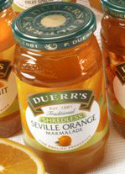 Paddington bear is celebrating his sixty-second birthday. Yes it's been over six decades since the Peruvian immigrant with a love for marmalade sandwiches arrived at a certain railway terminus and took up residence with the Brown family. Their housekeeper, Mrs Bird, instinctively knew that bears need plentiful supplies of that bitter-sweet breakfast jam if they're to maintain the shine on their fur. And so a message was sent to the local grocer for top up supplies. How times have changed. Now finding and purchasing a decent pot of marmalade suitable for south American bears and Wiltshire-born writers with a penchant for chunky, dark and sour marmalade is virtually impossible.
Paddington bear is celebrating his sixty-second birthday. Yes it's been over six decades since the Peruvian immigrant with a love for marmalade sandwiches arrived at a certain railway terminus and took up residence with the Brown family. Their housekeeper, Mrs Bird, instinctively knew that bears need plentiful supplies of that bitter-sweet breakfast jam if they're to maintain the shine on their fur. And so a message was sent to the local grocer for top up supplies. How times have changed. Now finding and purchasing a decent pot of marmalade suitable for south American bears and Wiltshire-born writers with a penchant for chunky, dark and sour marmalade is virtually impossible.
 I stuck with Duerrs Thick Cut Vintage for years and then suddenly about 15 years ago it disappeared. An unanswered query direct to Duerrs left me no nearer to finding fresh supplies of their sticky breakfast essential (the Thick Cut has since returned to Duerrs portfolio but it's too late now). So I turned to Duchy Original (a sloppy consistency allows it to slide off both knife and buttered toast) and Waitrose Organic thick cut – both satisfied my need for chunky marmalade without the unnecessary additions of caramel colouring, pectin and peel from fruits other than the Seville orange.
I stuck with Duerrs Thick Cut Vintage for years and then suddenly about 15 years ago it disappeared. An unanswered query direct to Duerrs left me no nearer to finding fresh supplies of their sticky breakfast essential (the Thick Cut has since returned to Duerrs portfolio but it's too late now). So I turned to Duchy Original (a sloppy consistency allows it to slide off both knife and buttered toast) and Waitrose Organic thick cut – both satisfied my need for chunky marmalade without the unnecessary additions of caramel colouring, pectin and peel from fruits other than the Seville orange.
But they just contained too much sugar. This was overpowering the jam's natural bitter bite obtained from the peel and pith's essential oils. These are leeched out during the initial orange peel soaking process prior to boiling the juice, sugar and peel infusion and turning the whole lot into what is essentially a sour jam.
There was only one alternative left. Make my own.
After much searching through recipe books and websites (BBC Good Food's Dark muscavado and whisky, and Delia's Dark Chunky seemed almost right) I settled on a recipe combination of the Bitter marmalade from the Slothful Cook and the very unsweet recipes provided by fellow members of the Allotments4All forum.
Six pounds of Seville oranges bought from Waitrose (the oranges are only around for a short period in January and February),  two lemons, eight pounds of Waitrose Fairtrade white granulated sugar (this worked out cheaper than their bog standard granulated) and half a pound of light brown sugar (to give the dark colour I wanted) were processed according to the Slothful Cook (use a skewer to poke a few holes in the oranges and then poach the oranges in water for about an hour and leave in the water overnight) and boiled vigorously with ten pints of water until a 'set' was achieved (a jam and marmalade makers term for when a fruit's natural pectin turns the liquid into a semi-solid mass – test by pouring a small amount of marmalade on a fridge-cooled saucer and poking your finger in it. If it wrinkles it's done).
two lemons, eight pounds of Waitrose Fairtrade white granulated sugar (this worked out cheaper than their bog standard granulated) and half a pound of light brown sugar (to give the dark colour I wanted) were processed according to the Slothful Cook (use a skewer to poke a few holes in the oranges and then poach the oranges in water for about an hour and leave in the water overnight) and boiled vigorously with ten pints of water until a 'set' was achieved (a jam and marmalade makers term for when a fruit's natural pectin turns the liquid into a semi-solid mass – test by pouring a small amount of marmalade on a fridge-cooled saucer and poking your finger in it. If it wrinkles it's done).
An over cautious nature combined with a first time recipe try-out left me not with the expected 17 one-pound jars of marmalade but 12. It's darker and more solid than expected due to the excessive water evaporation from too long a boil, but as I get through about one jar a month there is enough to see me through until next January when the Spanish fruit growers next export their crop.
If any of you are wondering if this lower than traditionally recommended ratio of sugar to fruit means I must keep my marmalade in the fridge, then the answer is no. After four months of munching through the jars I've seen no speck of mould (despite dipping in a buttery knife) from jars kept in the kitchen cupboard alongside other snack essentials of blackcurrant jam, gooseberry jam (products of allotment produce), local village-made honey and Marmite.
 Cheese and Marmite sandwiches are a necessary lunch-time snack for this writer. But as I eat them as soon as I've made them I have no need for the long term storage facilities provided by a slightly stained and battered hat.
Cheese and Marmite sandwiches are a necessary lunch-time snack for this writer. But as I eat them as soon as I've made them I have no need for the long term storage facilities provided by a slightly stained and battered hat.
 Pimm’s No.1 is the soaking liquor of choice for dried fruit then the Penguin Cookery Book’s 1952 version of Christmas cake has to be the recipe of choice. It’s quick, easy and you don’t need an O-level in home economics to get a really good result. To make a 7-inch cake you’ll need:
Pimm’s No.1 is the soaking liquor of choice for dried fruit then the Penguin Cookery Book’s 1952 version of Christmas cake has to be the recipe of choice. It’s quick, easy and you don’t need an O-level in home economics to get a really good result. To make a 7-inch cake you’ll need:
 Despite having a diverse culinary heritage inspired through invasion, it seems we British are more interested in mastering Italian cuisine than our own traditional dishes. A European-wide survey found that 61% of the Brits that responded would prefer to cook as Pietro and Paola rather than Peter and Paulas. But I've got news for those pasta throwing wanna-bes – ravioli and macaroni have been part of British culture for centuries.
Despite having a diverse culinary heritage inspired through invasion, it seems we British are more interested in mastering Italian cuisine than our own traditional dishes. A European-wide survey found that 61% of the Brits that responded would prefer to cook as Pietro and Paola rather than Peter and Paulas. But I've got news for those pasta throwing wanna-bes – ravioli and macaroni have been part of British culture for centuries.
 Less wine and more vinegar has been sampled this week as I’ve been sipping samples of hot home-made chutney straight from the boiling pan. After picking several tonnes, (well it seemed like it) of wild damsons and, its near neighbour, wild bullace from the Shropshire hedgerows I needed to find a recipe that would do justice to their flavours. After perusing many recipe books and websites, while finishing off the dregs of a bottle of South African red opened the night before, I finally came across just the recipe I was looking for.
Less wine and more vinegar has been sampled this week as I’ve been sipping samples of hot home-made chutney straight from the boiling pan. After picking several tonnes, (well it seemed like it) of wild damsons and, its near neighbour, wild bullace from the Shropshire hedgerows I needed to find a recipe that would do justice to their flavours. After perusing many recipe books and websites, while finishing off the dregs of a bottle of South African red opened the night before, I finally came across just the recipe I was looking for.


